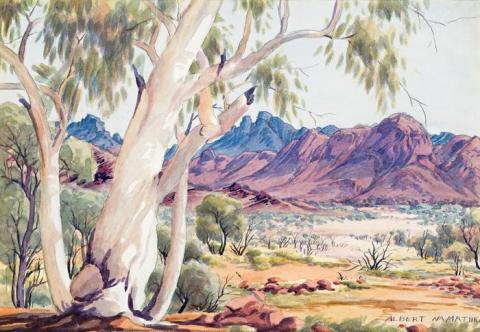ALICE SPRINGS COUNTRY, c.1955
Albert Namatjira
watercolour on paper
26.0 x 37.0 cm
signed lower right: ALBERT NAMATJIRA
Acquired from the artist in Alice Springs by Mr Edmund Downes, Ballarat, c.1955
Private collection, Melbourne
The art of Albert Namatjira celebrates the blending of two cultural traditions, presenting a brilliant collection of watercolours drawn from the best of both.
In Alice Springs Country and other works the unique Aboriginal knowledge of the land is translated into a Western form in which the images are riveting in their clarity of presentation and understanding. It is one of those grand moments when knowledge and vision combine. In the land of the Aranda people, the country made by Namatjira's creator ancestors in the Dreamtime, the artist exchanged traditional motifs and schematic representation for European technique and perspective. The result was both highly innovative and personal of vision. While the teaching of Rex Battarbee was central to his development, it was Namatjira's relationship to the land that was fundamental to his achievement. When a materialistic culture swamps a gentler one, the cultural losses are enormous; but it was given to Namatjira to be one of the first to find a way through, gaining national and international recognition.
While rhythm and repetition are central to Aboriginal art, the garb of Western art does not hide their presence in Namatjira's watercolours. In motifs such as trees and mountains, their forms may be changed, yet their reiteration speaks an indigenous language. Gum trees are invariably prominent foreground features, prompting the reference to his 'portraits of trees'.1 Typical is the white gum of two or three trunks on the very edge of the picture, as in this watercolour. It provides the key to the pictorial organization, of the sweep of the valley, peopled with olive foliaged trees and black trunks, red rocks, on to a blue and mauve backdrop of mountainous beyond. His formula incorporates the characteristic pattern of light and shade, brilliant clarity, and ever clear blue skies. Two similar examples to this painting, each identified as 'Untitled landscape 1955', are in the National Gallery of Australia, Canberra.
Namatjira also revisits favourite mountains and places - Haasts Bluff, Mount Connor near the Musgrave Ranges, Mount Sonder of the MacDonnell Ranges, Glen Helen and the primordial splendour of Palm Valley, which was his mother's country. Once misunderstood as working to a formula, today it can be appreciated as the repetition of Dreamtime stories owned by the artist. An inspiration to others, even beyond the school of watercolourists that followed him, his richly colourful and luminous works are now part of the Australian visual tradition, of a country in which natural wonderments and their spiritual associations are one. In this and other works, Albert Namatjira invites the viewer to enter into the landscape, and become part of it like his people.
1. French, A., Seeing the Centre: The Art of Albert Namatjira 1902-1959, National Gallery of Australia, Canberra, 2002, p. 117
DAVID THOMAS
